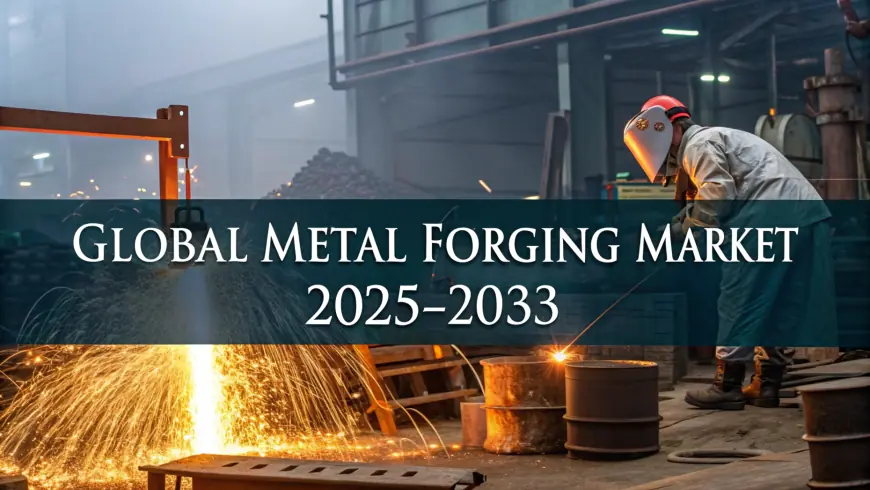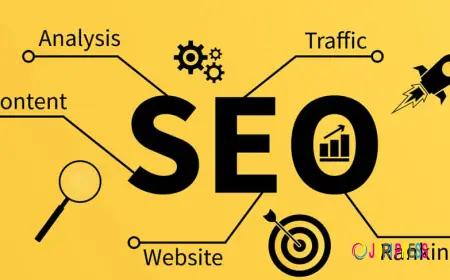Metal Forging Market Growth, Industry Share, Trends Analysis, and Forecast 2025-2033
The global metal forging market was valued at USD 90.0 Billion in 2024 and is anticipated to reach USD 145.4 Billion by 2033, exhibiting a CAGR of 5.44% during the forecast period from 2025 to 2033.

According to the latest report by IMARC Group, titled “Metal Forging Market Report by Raw Material (Carbon Steel, Alloy Steel, Aluminum, Magnesium, Stainless Steel, Titanium, and Others), Application (Automotive, Aerospace, Oil and Gas, Construction, Agriculture, and Others), and Region 2025-2033”, offers a comprehensive analysis of the global metal forging market growth. The report also includes competitor and regional analysis, along with a breakdown of segments within the industry.
How Big is the Metal Forging Market?
The global metal forging market size reached USD 90.0 Billion in 2024. Looking forward, IMARC Group expects the market to reach USD 145.4 Billion by 2033, exhibiting a growth rate (CAGR) of 5.44% during 2025-2033.
Request Free Sample Report: https://www.imarcgroup.com/metal-forging-market/requestsample
Global Metal Forging Market Dynamics:
Expanding Demand from Automotive and Aerospace Industries:
The global metal forging market is witnessing strong growth, largely driven by the increasing demand from the automotive and aerospace sectors. These industries require high-strength, durable, and lightweight forged components to enhance performance, ensure safety, and meet stringent emission norms. In automotive manufacturing, forged metal parts such as crankshafts, axles, and gears are critical for vehicle efficiency and structural integrity. Simultaneously, the aerospace sector's push for fuel-efficient aircraft has elevated the demand for titanium and aluminum forged components, which offer superior strength-to-weight ratios. With the rise in vehicle electrification and increased air travel, manufacturers are increasingly investing in forging technologies that ensure superior metallurgical properties and dimensional accuracy.
Furthermore, advancements in precision forging and die design are enabling the production of more complex geometries, thereby improving the applicability of forged parts across diverse vehicle platforms. This sustained demand is expected to remain a pivotal growth driver for the global metal forging market over the coming years.
Shift Toward Near-Net-Shape Forging and Advanced Alloys:
Technological innovation is reshaping the metal forging market, particularly with the growing shift toward near-net-shape forging and the use of high-performance alloys. Near-net-shape forging reduces material waste and minimizes the need for extensive post-forging machining, resulting in significant cost savings and faster turnaround times. This approach is gaining popularity across industries such as oil & gas, defense, and heavy machinery, where precision and efficiency are paramount. Additionally, the increasing adoption of advanced alloys like titanium, nickel-based superalloys, and high-strength steels is enhancing the mechanical properties of forged components, enabling them to perform reliably under extreme conditions.
These materials are especially crucial in high-temperature and high-pressure applications, where traditional metals may fail. Manufacturers are also leveraging computer-aided simulations and automated forging processes to improve product consistency and reduce production downtime. This shift not only supports sustainability through reduced waste but also contributes to improved operational efficiency and product quality across industries.
Strategic Integration of Digital Forging and Industry 4.0:
Digital transformation is playing a transformative role in the metal forging industry, with the integration of Industry 4.0 technologies such as IoT sensors, AI-driven analytics, and machine learning into forging operations. Smart forging systems enable real-time monitoring of temperature, pressure, and die alignment, resulting in enhanced process control and reduced defect rates. Predictive maintenance, powered by data analytics, is helping companies extend equipment life and avoid costly downtimes.
Moreover, the use of digital twins and simulation tools allows manufacturers to test and optimize forging parameters before production begins, improving design accuracy and minimizing trial-and-error iterations. This digitization trend is fostering a smarter, more connected manufacturing environment that enhances agility, productivity, and cost-efficiency. Companies that invest in such digital initiatives are better positioned to meet evolving customer expectations, manage customized production runs, and respond swiftly to market shifts, ultimately gaining a competitive advantage in the global metal forging landscape.
Global Metal Forging Market Trends:
The metal forging industry is experiencing a paradigm shift, shaped by the convergence of sustainability goals, digital manufacturing, and rising demand for lightweight components. As industries strive to reduce carbon footprints and increase fuel efficiency, there's a marked increase in the use of lightweight forged metals such as aluminum and magnesium alloys. Simultaneously, the adoption of green forging practices—such as energy-efficient furnaces and closed-die techniques—is becoming more prevalent to minimize environmental impact. Digitization is also making inroads, with smart sensors and automation streamlining production and improving product traceability.
Moreover, customization and small-batch production are gaining traction, driven by the need for precision-engineered parts in emerging applications like electric vehicles, renewable energy, and space exploration. These evolving trends indicate a robust transformation of the metal forging market, pointing toward a future defined by innovation, sustainability, and technological integration.
By the IMARC Group, Some of the Top Competitive Landscape Operating in the Metal Forging Market are Given Below:
The Display Market research report outlines a detailed analysis of the competitive landscape, offering in-depth profiles of major companies. Some of the key players in the market are:
- Arconic Corp.
- ATI
- Bharat Forge Ltd.
- Bruck GmbH
- China First Heavy Industries
- Ellwood Group Inc.
- Jiangyin Hengrun Heavy Industries Co. Ltd.
- Nippon Steel Corp.
- Precision Castparts Corp. (Berkshire Hathaway Inc)
- Kovárna Viva
- Larsen & Toubro Limited
- Scot Forge
- Thyssenkrupp AG
Explore the Full Report with Charts, Table of Contents, and List of Figures: https://www.imarcgroup.com/metal-forging-market
Global Metal Forging Market Trends:
The trends that affect the global metal forging market are on the rise. One major trend is the use of near-net-shape forging methods which, when compared to traditional machining, require less subsequent and secondary processes. This result in surplus material being economized, production costs being reduced, operations being more favorable from an energy standpoint, and overall efficiency ameliorated. Forging design and process modeling and simulation are becoming more prevalent. These tools enable the optimization of designs and processes in advance, which yields higher quality products and shorter lead times with physical forgings.
There is, however, more focus on the need of lightweight forged components for automotive and aerospace industries as fuel and emission restrictions increase. This increases R&D directed towards forwarding the lightweight materials such as aluminum and magnesium alloy forgings. In addition, there is more emphasis on automation and digitization of the processes, more specifically the integration of robotics and data analytic systems that improve productivity, control the quality, and enhance maintenance by enabling predicative analysis.
Green Tea Market Report Segmentation:
Breakup by Raw Material:
- Carbon Steel
- Alloy Steel
- Aluminum
- Magnesium
- Stainless Steel
- Titanium
- Others
Carbon steel accounts for the majority of the market share
Breakup by Application:
- Automotive
- Aerospace
- Oil and Gas
- Construction
- Agriculture
- Others
Automotive holds the largest share in the industry
Regional Insights:
- North America (United States, Canada)
- Asia Pacific (China, Japan, India, Australia, Indonesia, Korea, Others)
- Europe (Germany, France, United Kingdom, Italy, Spain, Others)
- Latin America (Brazil, Mexico, Others)
- Middle East and Africa (United Arab Emirates, Saudi Arabia, Qatar, Iraq, Other)
Key highlights of the Report:
- Market Performance
- Market Outlook
- COVID-19 Impact on the Market
- Porter’s Five Forces Analysis
- Historical, Current and Future Market Trends
- Market Drivers and Success Factors
- SWOT Analysis
- Structure of the Market
- Value Chain Analysis
- Comprehensive Mapping of the Competitive Landscape
Note: If you need specific information that is not currently within the scope of the report, we can provide it to you as a part of the customization.
About Us
IMARC Group is a leading market research company that offers management strategy and market research worldwide. We partner with clients in all sectors and regions to identify their highest-value opportunities, address their most critical challenges, and transform their businesses.
IMARC’s information products include major market, scientific, economic and technological developments for business leaders in pharmaceutical, industrial, and high technology organizations. Market forecasts and industry analysis for biotechnology, advanced materials, pharmaceuticals, food and beverage, travel and tourism, nanotechnology and novel processing methods are at the top of the company’s expertise.
Contact US:
IMARC Group
134 N 4th St. Brooklyn, NY 11249, USA
Email: [email protected]
Tel No:(D) +91 120 433 0800
United States: +1-201971-6302
What's Your Reaction?
 Like
0
Like
0
 Dislike
0
Dislike
0
 Love
0
Love
0
 Funny
0
Funny
0
 Angry
0
Angry
0
 Sad
0
Sad
0
 Wow
0
Wow
0

















































